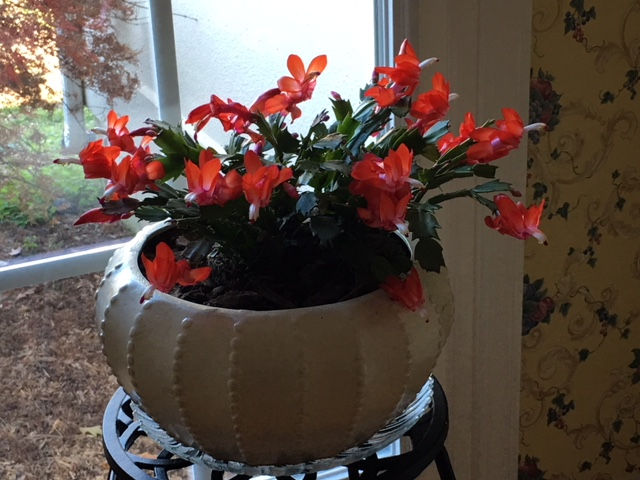Looking Back
- Robin Ford Wallace
- Sep 22, 2018
- 3 min read

Two years ago I purchased a pitifully punky plant (below, right) to illustrate an article I wrote in this space about Christmas cacti. It survived my benign neglect throughout that winter. When spring arrived, I set it out under a tree and basically let nature take its course. In the last week of September I prepared to bring it into the house before nighttime temperatures dipped into the 30s. It had grown dramatically and demanded to be repotted.
Knowing that it is not a cactus but an epiphyte, I chose orchid mix rather than cactus mix for the potting medium. Orchids are also epiphytes, which means that, using other plants for support, they get nutrients from the air, rain and accumulating debris rather than from soil.
After placing the plant in a nice new home, I left it out on the covered porch because it needs a cool (50-55 degree) environment to set flowers. It also needs to be in total darkness for 14 hours out of 24 because Christmas cacti bloom when days are 8-10 hours in length.
To simulate the long nights, I placed a box over the plant in late afternoon, removing it in the morning. As nighttime lows hovered in the low 40s, I moved the “cactus” to my unheated garage and continued the box treatment. I was rewarded with abundant flower buds in early November and moved the plant to a room in which I closed the heating vent. It bloomed in mid-November, finishing flowering around Turkey Day. To my surprise, it had a little rebloom in late winter.
This year I plan to delay the box treatment until mid-October. Hopefully, I will have the plant blooming in December.
Should you wish to read the original Christmas cactus column, click the photo above. Or go to "Columns" under the navigator and you can find all my previous articles archived under "Bartlett on Gardening."
For what the plant looked like after the box treatment, see the photo below.

Since we're strolling down Memory Lane today, I want to follow up as well on my June 23 column about solarization. (Click picture of the sun to go to that one.) A fellow master gardener volunteer is also interested in this process, which uses intensified sunlight to kill weeds and prepare a plot for gardening. She tried it on an overgrown garden plot and has let us know how it has worked out.
First, she found the site preparation to be more difficult and time consuming than anticipated. (My fear that that would be the case kept me from trying it this summer.) In her latest report, she says that 3-mil. thick plastic did not hold up and the experiment was a failure.
We had both read an article on the topic published by the University of California at Davis, which is located a stone’s throw from Sacramento. California’s Central Valley is one of the unsung hot spots in America. Not only are the longest days of the year triple-digit hot, but there is zero rainfall between mid-spring and fall. This makes for plenty of long, hot, sunny days, ideal solarizing weather.

Given our stormy summer here in the Southeast, solarization was not the best option this year.
Master gardener Ann Barton pots, putters, plays and performs mad experiments in the ornamental beds around her home. You can email her at arose56@hamilton.net.






Comments